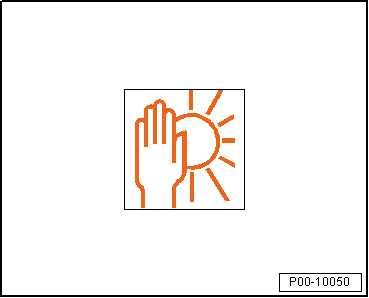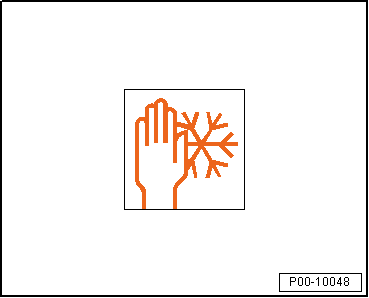Volkswagen Touran Service Manual: Long-Term Underbody Protection -D 314 D38 M2-, Bright Color
| Long-Term Underbody Protection -D 314 D38 M2-, Bright Color |
| Long-Term Underbody Protection -D 314 D38 M2- is a bright,
transparent coating compound (not opaque) with a watery
synthetic dispersion base that is sprayed with a UBS-, paint- or
filler spray gun. |
| The drying time depends on the layer thickness, ambient
temperature and the surrounding humidity. Good ventilation and
higher temperatures quicken the drying time. |
| The dried film shows good adhesion to galvanized and
cathodic primed steel panels, as well as painted base surfaces.
Due to the high resistance to abrasion and low-temperature
flexibility, the long-term underbody protection is characterized
by its quality stone chip protection characteristics. |
| The long-term underbody protection can be quickly
applied/painted over with water-based paints. |
| After air drying (approximately two to three hours), the
material can also be painted over with conventional painting
systems (contains solvents). |
| The long-term underbody protection can be colored, mixed
with water-based paints and diluted with demineralized water. To
color, an addition of up to 30 % volume of ready to spray
water-based paint is possible. |
| Due to the variations of mixture ratios, application
pressures and intervals, smooth surfaces and fine to coarse
structures can be produced. |
| The material is only temporarily resistant to gasoline and
cold cleaners. |
| Long-Term Underbody Protection -D 314 D38 M2- is suited for
repair work on the underbody, wheel housing, front and rear
areas. It is used on visible components, such as on the side
sill, as paintable protection against stone impact, road salt
and moisture corrosion. |
| The material is used to reestablish different surface
structures on vehicles of all types after a repair. |
| The variable pigmentability is of a particular advantage.
Any possible scratches or stone impacts become almost invisible. |
 Note
| Before starting to apply, it is necessary to read the safety
measures and advice in the safety data sheet. |
| Even for products which are not required to be labeled by
law, the usual safety measures must be observed for chemical
emissions. |
| Clean the surfaces to be treated well beforehand and remove
any rust. |
| The surfaces must be free from dirt and dust, dry and
grease-free. |
| Surfaces which are not to be coated should be covered with
paper. |
| Bare steel surfaces are to be primed before applying the
long-term underbody protection. |
| The long-term underbody protection can be applied to all
conventional sealants (except silicone) and is characterized by
its good adhesion. |
| The long-term underbody protection surface can become weaker
with plasticized sealants and also have a certain tackiness.
However the material does not lose its adhesiveness. |
| Shake the can contents thoroughly before using. |
| The long-term underbody protection is applied using
rustproof filler- or paint spray guns. The material can be
diluted with distilled or demineralized water (purified water)
for adjustment (maximum 10% of volume addition). |
| The first layer should not be applied too thickly (
spray application). |
| The long-term underbody protection is mixable with
spray-ready water-based paints (maximum 30% of volume addition). |
| The replicate the conventional structures, the best results
are achieved using a 10-15 % spray-ready painting technique. |
| The material should be filtered using a paint strainer
before applying. |

Caution
| Do not spray onto the steering, engine, driveshaft,
exhaust, catalytic converter and brake systems. |
| Blow out the spraygun immediately after use and then
rinse it with Plastic Cleaner -D 195 850 A1-. |
| If the spray gun becomes blocked the can may burst! |
| Observe the operating instructions of the UBS spray
gun! |
|
 Note
| The long-term underbody protection can be painted over with
water-based and solvent-containing paints. Due to the large
number of available systems on the market, testing is necessary. |
| 1 - |
Painting Over with Water-Soluble Paints: |
| |
After a short drying period (matte surface), the long-term
underbody protection can be painted over up to 72 hours after
applying with water-soluble paints. |
| 2 - |
Painting Over with Conventional (Solvent-Containing) Paints: |
| |
After drying, the long-term underbody protection can be
painted over up to 72 hours after applying with conventional
(solvent-containing) paints. The material has a quick-drying
thick layer system. If accelerating the drying period in an
airflow, then make sure that the rapidly forming film is not
being actively blown onto the material that is still drying.
This could lead to crack formation. |
| Splashes on painted surfaces should be removed immediately
using Plastic Cleaner -D 195 850 A1-. |
| Equipment or the dirty parts of the equipment should be
cleaned after applying water, and if necessary, adding of a
watery cleaner. Do no use any solvent-containing cleaners
(clotting). After drying, the long-term underbody protection can
only be removed using a tool. |
|
|
|
|
Technical Data: |
| Color |
whitish, not opaque |
| Odor |
slightly like ammonia |
| Density |
approximately 1.25 g/cm³ |
| Solid matter content |
approximately 70 % |
| Viscosity: |
1 Pas |
| Measuring
instrument |
Rheomat STV |
| Measuring system |
Rotor 30 |
| Speed |
200 UpM |
| Stability |
up to 1 mm wet |
| Processing temperature |
+10 C to +25 C (50 to
77 F) |
| Application temperature |
-25 C to +80 C (-13 to 176
F) (short-term, up to one hour at +100 C (212 F)) |
| Guaranteed shelf life of 12 months from date of manufacture.
Use no later than the date indicated on the label and store in
original container at +20 C (68 F). |
|
|

|
| The recommended storage temperature for the long-term
underbody protection is +10 C to +25 C (50 to 77 F). |
| The long-term underbody protection is vulnerable to frost.
It must not fall below +5 C (41 F). |
|
|

|
Definition:
Long-Term Underbody Protection -D 314 D37 M2-, Black
Edition 02/2010
Product description of ...
© 2016-2025 Copyright www.vwtouran.net | 0.0062

 Note
Note Note
Note

 Long-Term Underbody Protection -D 314 D37 M2-, Black
Long-Term Underbody Protection -D 314 D37 M2-, Black

 Caution
Caution